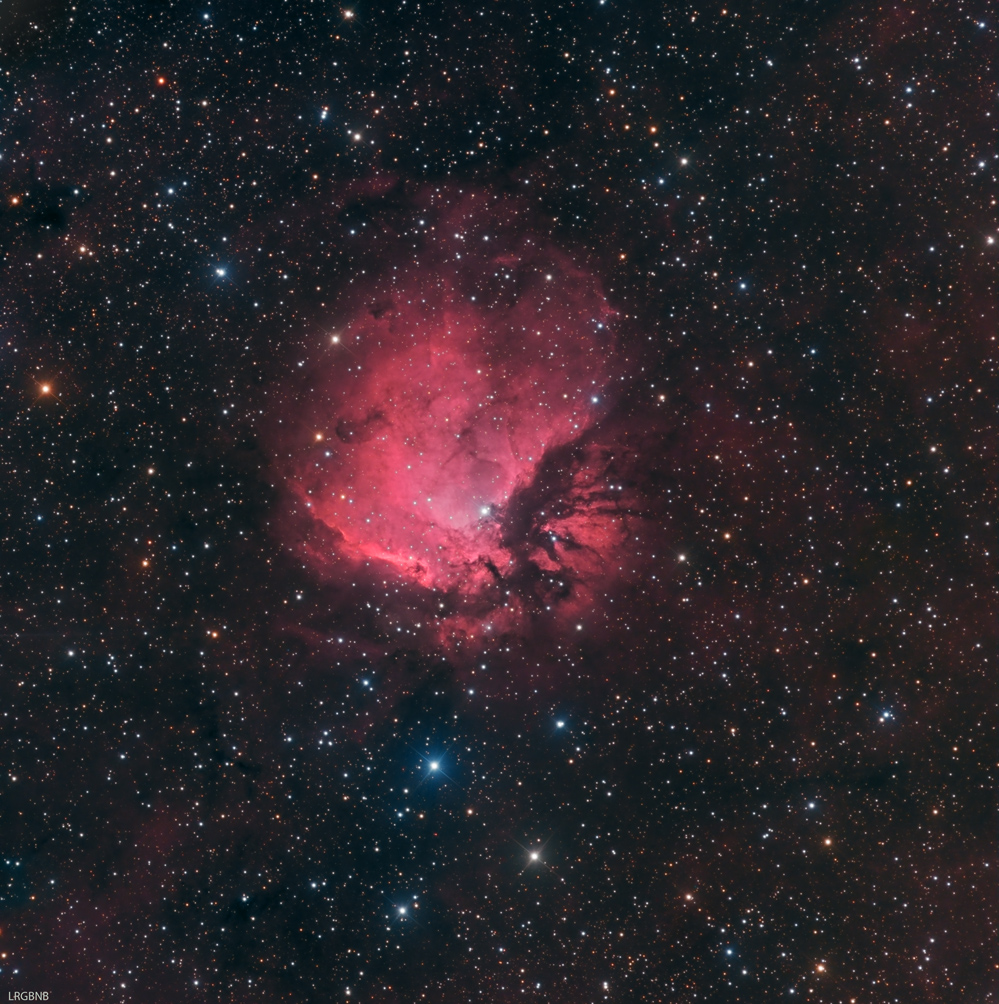HOME
Sh2-112
Sh2-112
Sharpless 112
Emission Nebula in Cygnus
Click here for higher-resolution versions: 40% (1598x1606) 65%
(2597x2610) 100% (3996x4016)
 Click on image to cycle through the four versions of the image (described below and labeled on the lower left corner of each image)
Click on image to cycle through the four versions of the image (described below and labeled on the lower left corner of each image)
Sh2-112 is an emission nebula visually located in the summer constellation Cygnus (the heart of the Milky Way, which explains the dense starfield). It is predominantly
red, because (i) ionized hydrogen emits in the red part of the spectrum; (ii) the vast majority of the light matter in the universe is hydrogen, and (iii) the hydrogen in this image is being
ionized (stripped of its electron) by a highly-energetic young star inside the hydrogen cloud.
The nebula is thought to be about 5600 light years from Earth; at that distance, the brighter part of the nebula would be 37 light years across. Visually, it is about half the width of a full moon.
I have presented this object in four different formats (each image is labeled in the lower left corner); I like each one in its own way. This is the order in which they appear as you cycle
through (by repeatedly clicking on the photo, waiting for each to download):
(i) A true-color version (the top photo in the stack), with the color created by imaging through red, green and blue filters (with a significant amount of Ha and OIII
data blended into various channels, in varying percentages; Ha emissions are in the red spectrum, and OIII emissions are blue-green, so I have blended Ha into the luminance layer and the red channel,
and OIII into the green and blue channels);
(ii) A true-color version, without using any narrow band data (all color is derived from data collected through red, green and blue filters), as a comparison to the
result when loaded with NB data.
(iii) A version in the Hubble palette (a lot of the Hubble photos, including and especially the famous "Pillars of Creation," are made with this set of filters, since
it's a useful set for scientists to see what's actually happening), which shows SII emissions as red, Ha emissions as green, and OIII emissions as blue (with the Ha emissions de-emphasized in this
rendition because they would be so dominant otherwise--but I still keep a lot of green in the nebula). I like the clear blue when a nebula has significant oxygen emissions. To compare this to
another popular way of presenting SHO data--converting the green to a tan/orange, click here);
(iv) A pure Ha version (grayscale, showing only light in the very narrow Ha band); this is fun for me to gaze at in full resolution, to see all the detail.
These are the most frequent ways images of emission nebulae are likely to be presented, so I thought it would be fun to include all of them, to be able to compare and contrast the different presentations.
The "true color" version which includes narrow-band data is, to me, the most beautiful of the lot, so I put it at the top; the narrow-band data adds contrast, depth and detail to the colors and the image,
and makes the stars smaller, which is pleasing to me, while maintaining the "true color" nature of the data. The Hubble palette version is interesting, showing the dominance of the Ha emissions, while also
showing that there are significant OIII emissions (the blue) and even some SII emissions (the yellow/orange pieces), and it's nice to include the (relatively sparse) sulfur emissions that I spent a bunch
of hours gathering.
The grayscale Ha image is, to me, striking in its smoothness (and the gray, of course, is the color you see when you look at this through a telescope). And the traditional LRGB, without using any narrow
band data, also is for comparison purposes, to show the benefits of including narrow-band data in a true-color image (compare to the top image, which has more detail, deeper colors and smaller stars).
This object reminds me a lot of the Pacman Nebula.
Technical Information:
Ha:OIII:SII:L:R:G:B: 660:660:660:675:180:180:240 (a total of over 54 hours of light-frame exposure time); luminance, red and green exposures were all 15-minute exposures;
blue all 20-minute exposures; Ha, SII and OIII were all 30-minute exposures.
Equipment: RC Optical Systems 14.5 inch Ritchey-Chretien carbon fiber truss telescope, with ion-milled optics and RCOS field flattener, at about f/9, and an SBIG STX-16803 camera with
internal filter wheel (SBIG filter set), guided by an SBIG AO-X, all riding on a Bisque Paramount ME German Equatorial Mount.
Image Acquisition/Camera Control: Maxim DL, controlled with ACP Expert/Scheduler, working in concert with TheSky X.
Processing: All images calibrated (darks, bias and sky flats), aligned, combined and cropped in Pixinsight. Color combine in Pixinsight. Some finish work (background neutralization,
color calibration, deconvolution, noise reduction and wavelet sharpening) done in Pixinsight; some cleanup finish work was done in Photoshop CC.
Location: Data acquired remotely from Sierra Remote Observatories, Auberry, California, USA.
Date: Images taken on many nights in October, November and December of 2020, and August, September and October of 2021. Image posted November 5, 2021.
Date: Image scale of full-resolution image: 0.56 arcseconds per pixel.
Seeing: Generally good, with individual calibrated luminance frames varying from 1.9 to 2.4 arcsecond FWHM.
CCD Chip temperature: -25C
Copyright 2020,2021 Mark de Regt
